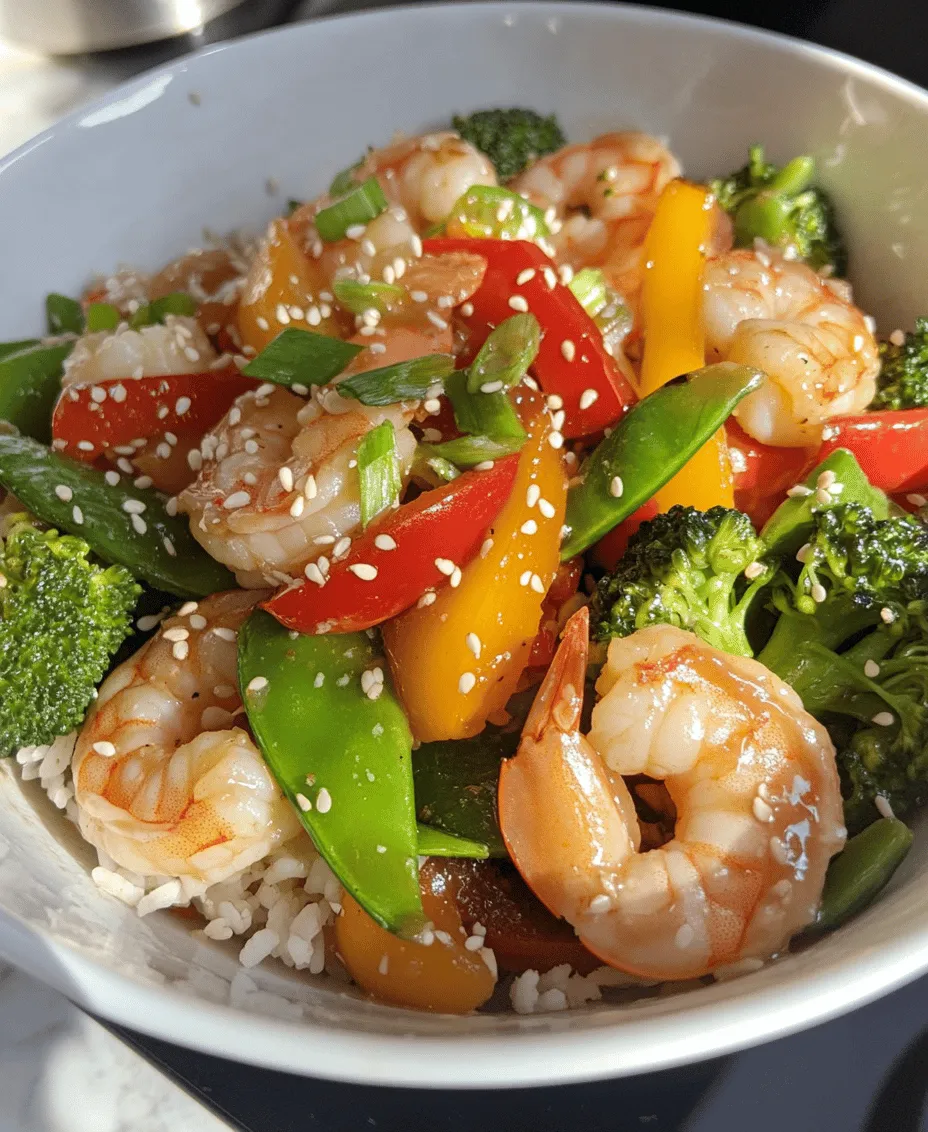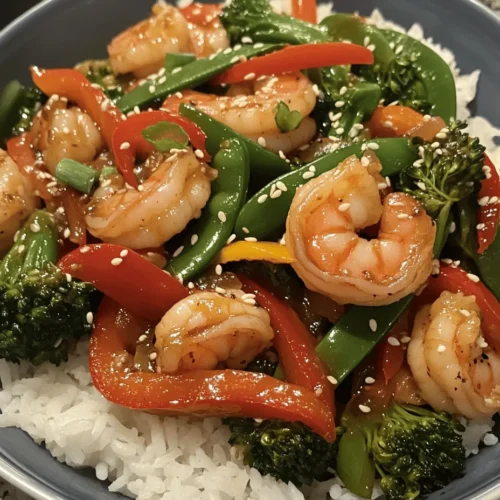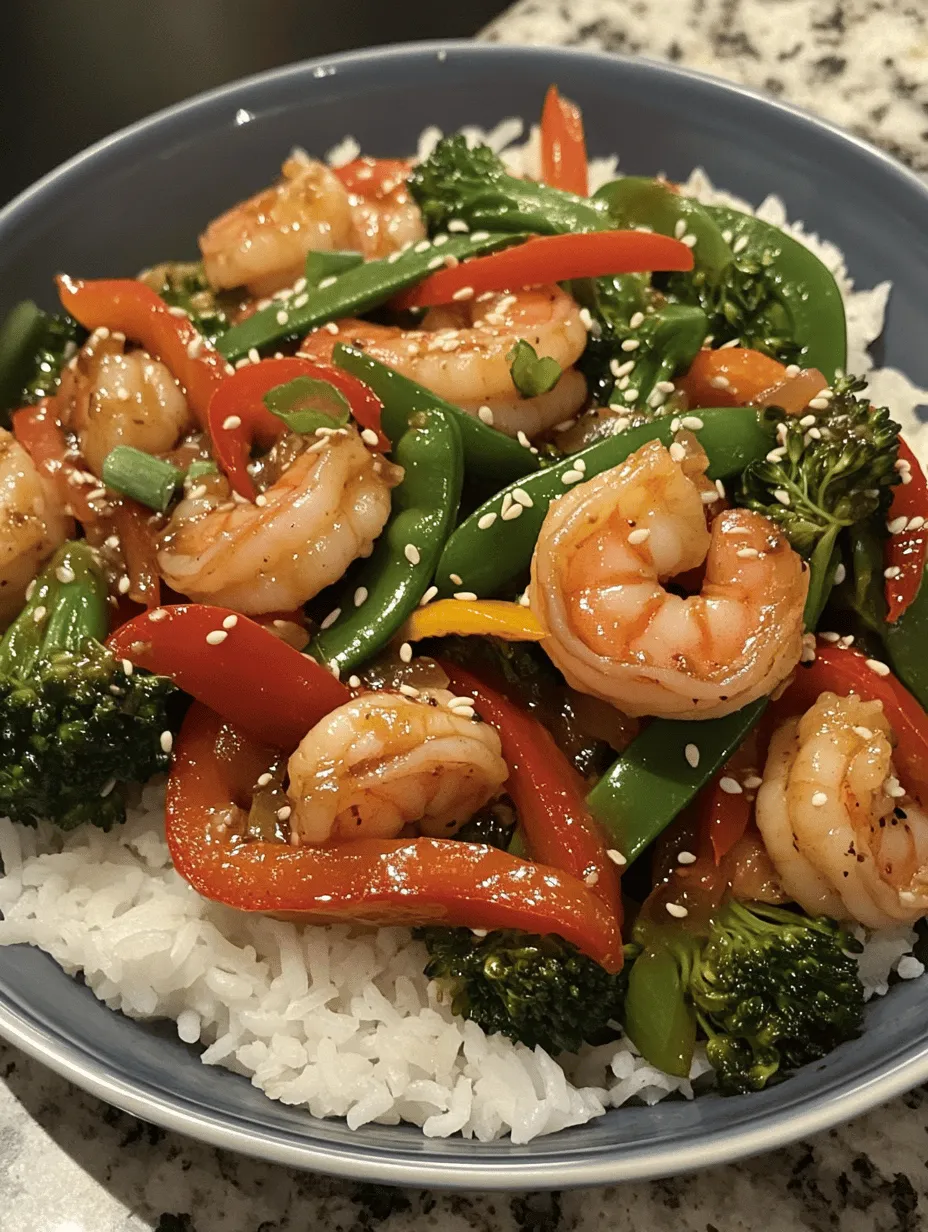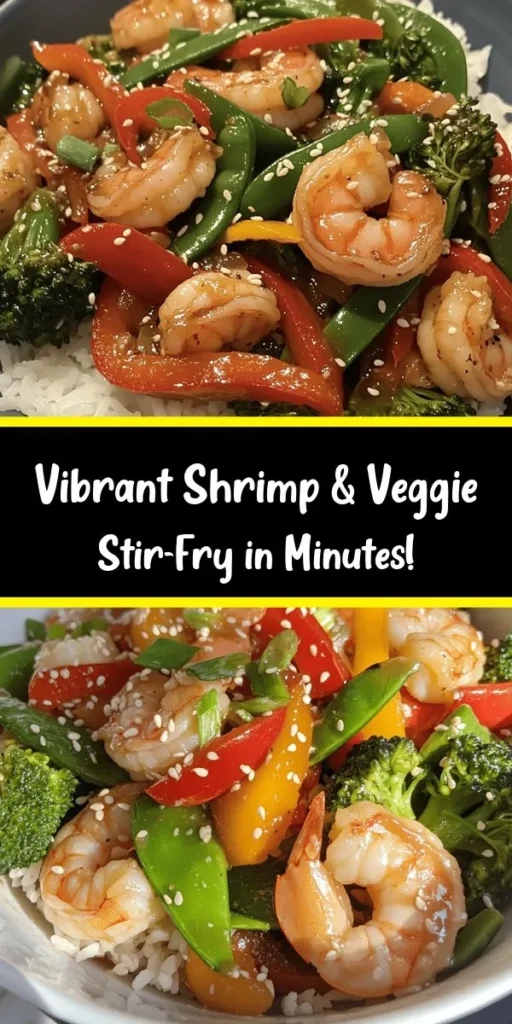Introduction
When it comes to quick and satisfying meals, few dishes can rival a vibrant shrimp and veggie stir-fry. This dish is not only visually appealing with its rainbow of colors, but it also bursts with flavor and nutrition, making it a perfect choice for busy weeknights or casual gatherings. With its combination of succulent shrimp and crisp vegetables, this stir-fry is a testament to how simple ingredients can create a delightful culinary experience.
Stir-frying, a technique that originated in China thousands of years ago, is renowned for its ability to cook food quickly while preserving flavor and nutrients. This method involves cooking food over high heat in a small amount of oil, allowing for rapid cooking and the preservation of the vibrant colors and textures of the ingredients. It’s an ideal cooking style for those who want to whip up a meal in a flash without compromising on quality or taste.
Moreover, both shrimp and a variety of vegetables offer an array of nutritional benefits. Shrimp are low in calories yet high in protein, making them an excellent choice for anyone looking to maintain a healthy diet. They are also rich in omega-3 fatty acids, which are beneficial for heart health, and contain essential nutrients like selenium and vitamin B12. On the other hand, mixed vegetables bring a wealth of vitamins, minerals, and fiber to the table, contributing to overall health and wellness. Incorporating a variety of vegetables not only enhances the dish’s flavor but also ensures that you are consuming a balanced meal.
In this article, we will guide you through the process of making a quick and colorful shrimp and veggie stir-fry, exploring the essential ingredients, preparation steps, and cooking techniques needed for a delicious result.
Understanding the Ingredients
To create a standout shrimp and veggie stir-fry, it’s crucial to understand the ingredients that will make up this dish. Each component plays a significant role in both flavor and nutrition.
Shrimp: Health Benefits and Sourcing Tips
Shrimp are a fantastic source of lean protein, making them an excellent option for those looking to build muscle or maintain a healthy weight. They contain about 24 grams of protein per 100 grams, which helps in muscle recovery and growth. Additionally, shrimp are low in calories and fat, making them a diet-friendly choice.
When purchasing shrimp, freshness is key. Look for shrimp that are firm to the touch with a mild, briny smell; avoid any that have an overpowering fishy odor. It’s also essential to consider sustainability when sourcing your shrimp. Opt for wild-caught shrimp when possible, as they are generally considered more environmentally friendly compared to farmed varieties. If you’re unsure about the origins of the shrimp, look for certifications on the packaging that indicate sustainable practices.
Mixed Vegetables: Nutritional Value and Best Options
Mixed vegetables not only add color and texture to your stir-fry but also pack a powerful nutritional punch. Vegetables are rich in essential vitamins, minerals, and antioxidants, all of which contribute to overall health. Common choices for stir-frying include bell peppers, broccoli, carrots, and snap peas, each offering unique health benefits:
– Bell Peppers: High in vitamin C, these crunchy vegetables help boost the immune system and enhance skin health.
– Broccoli: A cruciferous vegetable rich in fiber, vitamins C and K, and various antioxidants, broccoli supports digestive health and has anti-inflammatory properties.
– Carrots: Packed with beta-carotene, carrots are excellent for eye health and provide a good source of fiber.
– Snap Peas: These sweet, crunchy vegetables are high in protein and vitamin C, making them a great addition to any stir-fry.
When selecting vegetables, choose a colorful mix to maximize the range of nutrients. Freshness is paramount; look for vibrant colors and firm textures, avoiding any that appear wilted or discolored.
Essential Sauces: Soy Sauce, Oyster Sauce, and Sesame Oil
A key component of any stir-fry is its sauce, which adds depth and flavor to the dish. In this recipe, we will focus on three essential sauces: soy sauce, oyster sauce, and sesame oil.
– Soy Sauce: A staple in Asian cooking, soy sauce is made from fermented soybeans and adds a savory umami flavor to dishes. It’s available in various types, including light, dark, and low-sodium versions. For a healthier option, consider using low-sodium soy sauce to control the saltiness of your dish.
– Oyster Sauce: Known for its rich, slightly sweet flavor, oyster sauce is made from oyster extracts, sugar, and soy sauce. It enhances the overall taste of the stir-fry and pairs exceptionally well with shrimp and vegetables.
– Sesame Oil: This oil, made from sesame seeds, has a distinct nutty flavor that can elevate the dish. Typically used as a finishing oil, a drizzle of sesame oil adds a delightful aroma and taste at the end of cooking.
Using high-quality sauces can make a significant difference in the flavor of your stir-fry. Look for brands that use natural ingredients without excessive preservatives or additives.
Importance of Fresh Ingredients for Flavor and Health
Using fresh ingredients is crucial when preparing a shrimp and veggie stir-fry. Fresh shrimp and vegetables not only taste better but also retain their nutrients more effectively than frozen or canned counterparts. Fresh ingredients will enhance the overall flavor profile of your dish, making it more enjoyable to eat.
Whenever possible, visit local farmers’ markets or grocery stores that prioritize fresh produce. This practice not only supports local agriculture but also ensures you are getting the freshest ingredients available.
Preparing Your Ingredients
The secret to a successful stir-fry lies in preparation. Having all your ingredients prepped and ready to go before you start cooking is essential, as the cooking process happens quickly and can easily become overwhelming without proper organization.
The Importance of Preparation in Cooking
Preparation is not just about chopping vegetables and thawing shrimp; it’s about setting yourself up for success. The stir-frying process requires your full attention, as ingredients must be added in quick succession to achieve the desired texture and flavor. By preparing your ingredients ahead of time, you can focus on the cooking process without distractions.
Step-by-Step Guide to Prepping Shrimp and Vegetables
Thawing and Drying Shrimp
If you are using frozen shrimp, it’s essential to thaw them properly. The best method is to transfer them from the freezer to the refrigerator the night before to allow them to thaw gradually. If you’re short on time, place the shrimp in a bowl of cold water for about 15-20 minutes until they are fully thawed.
Once thawed, it’s important to dry the shrimp thoroughly. Excess moisture can cause the shrimp to steam rather than sear when placed in the hot pan. Use paper towels to pat them dry before seasoning.
Chopping Vegetables for Stir-Frying
The next step is preparing your vegetables. Begin by washing them thoroughly under cold water to remove any dirt or pesticides. After washing, it’s time to chop them into uniform pieces. This is crucial for even cooking; if some pieces are larger than others, they may not cook through at the same rate.
For bell peppers, remove the seeds and core, then slice them into thin strips. Broccoli can be cut into bite-sized florets, and carrots should be sliced into thin rounds or julienned for quicker cooking. Snap peas can be left whole, but make sure to trim the ends. Aim for consistency in the size of your vegetable pieces to ensure they cook evenly in the stir-fry.
The Cooking Process
Now that you’ve prepared your ingredients, it’s time to dive into the cooking process. The stir-frying technique is straightforward but requires attention to detail for the best results.
Overview of Stir-Frying Technique
Stir-frying involves cooking food quickly over high heat while stirring continuously. This technique allows you to achieve a perfect sear on your shrimp while keeping your vegetables crisp and vibrant. A well-seasoned wok or a large skillet is ideal for this cooking method, as it provides ample space for tossing the ingredients.
It’s essential to ensure that your pan is hot enough before adding any ingredients. A properly heated pan will create a sizzling sound when you add the shrimp, locking in their juices and enhancing their flavor.
Heating the Pan: The Significance of Temperature
The key to successful stir-frying is temperature control. Begin by preheating your pan over medium-high heat. Once the pan is hot, add a small amount of oil—preferably a high smoke point oil like vegetable oil or canola oil—to the pan. Swirl the oil around to coat the surface evenly.
Before adding the shrimp, test the pan’s heat by dropping a small piece of vegetable into the oil; if it sizzles immediately, you’re ready to go. If the pan isn’t hot enough, your food will steam rather than stir-fry, resulting in a less desirable texture and flavor.
In the next part of this article, we will delve deeper into the cooking process, including how to add your ingredients in the right order, tips for achieving the perfect stir-fry, and serving suggestions that will elevate your dish. Stay tuned for a comprehensive guide to making your quick and colorful shrimp and veggie stir-fry a culinary triumph!

Cooking Shrimp: Timing and Indicators for Doneness
Cooking shrimp to perfection is essential for achieving that tender, juicy bite. Start by heating your wok or frying pan over medium-high heat, adding a splash of oil to coat the surface. Once the oil is shimmering, it’s time to add the shrimp.
Cook the shrimp for about 2 to 3 minutes on one side. As they cook, keep an eye on their color; they will transition from a grayish hue to a vibrant pink. Flip the shrimp and cook for an additional 1 to 2 minutes. The shrimp are done when they curl into a C-shape and become opaque throughout. Overcooking shrimp can lead to a rubbery texture, so be vigilant! If you have a meat thermometer, the internal temperature should reach 120°F (49°C) for safe consumption.
Stir-Frying Vegetables: Preserving Flavor and Nutrients
Vegetables are a vital component of any stir-fry, not only adding color and texture but also essential nutrients. To retain their crispness and nutritional value, it’s crucial to stir-fry them properly.
Start by adding the vegetables that take longer to cook, such as bell peppers and broccoli, first. Sauté these for about 3 to 4 minutes, stirring frequently to ensure even cooking. Next, add quicker-cooking vegetables like snap peas or carrots, which need only about 2 minutes. The key is to cook them over high heat while stirring constantly. This method preserves their vibrant colors and crunch, ensuring they don’t become mushy.
Combining Ingredients: Achieving the Best Flavor Balance
Once your shrimp and vegetables are cooked to perfection, it’s time to bring everything together. Add the shrimp back into the pan with the vegetables and pour in your chosen sauce—soy sauce, oyster sauce, or a homemade stir-fry sauce. Stir everything together, allowing the sauce to coat the shrimp and veggies evenly.
Cook for an additional minute to let the flavors meld, and consider adjusting the seasoning. Taste the stir-fry and decide if it needs a splash more soy sauce, a pinch of salt, or a dash of pepper. Balancing these flavors is crucial for a delightful dish.
Serving Suggestions
Presentation Tips for an Appealing Dish
Presentation can elevate your stir-fry from simple to spectacular. Start by using a large, shallow bowl or a vibrant plate. Layer your stir-fry neatly, showcasing the colorful shrimp and vegetables. Consider placing the shrimp on top to highlight their beautiful pink color, and arrange the vegetables artistically around them. Drizzle a small amount of sauce over the top for a glossy finish.
Pairing Options: Cooked Rice vs. Noodles
When it comes to serving your shrimp and veggie stir-fry, the choice between rice and noodles is largely a matter of personal preference. Serve the stir-fry over a bed of fluffy white or brown rice for a wholesome meal. Alternatively, toss the stir-fry with cooked noodles, allowing the sauce to cling to the noodles for a heartier dish. Either option complements the vibrant flavors of the stir-fry beautifully.
Garnishing Ideas: Sesame Seeds and Green Onions
To add the finishing touch to your dish, consider garnishing with toasted sesame seeds and thinly sliced green onions. The sesame seeds add a delightful crunch and nutty flavor, while the green onions provide a fresh, sharp contrast. A drizzle of sesame oil or a sprinkle of crushed red pepper can also enhance the aroma and flavor profile, making your dish even more appealing.
Nutritional Analysis
Breakdown of Calories and Nutrients per Serving
A serving of shrimp and veggie stir-fry typically contains around 300 to 400 calories, depending on the amount of oil and sauce used. The shrimp are a fantastic source of protein, providing about 20 grams per serving, along with essential vitamins and minerals such as vitamin B12, iodine, and selenium. The vegetables contribute fiber, vitamins A and C, and various antioxidants, making this dish not just delicious but also nutritious.
Health Benefits of Shrimp in a Balanced Diet
Shrimp is an excellent protein choice for those looking to maintain a balanced diet. Its low-calorie count combined with high protein content makes it a suitable option for weight management. Rich in omega-3 fatty acids, shrimp supports heart health and can help lower inflammation in the body. Moreover, the selenium found in shrimp plays a vital role in supporting the immune system and thyroid function, proving that this seafood can be a valuable part of your diet.
Role of Vegetables in Maintaining Overall Health
Incorporating a variety of vegetables into your meals is crucial for overall health. They are low in calories and high in essential nutrients, contributing to better digestion, reduced risk of chronic diseases, and improved skin health. The fiber in vegetables aids in digestion and helps maintain a healthy weight, while vitamins and minerals support various bodily functions. By enjoying a colorful stir-fry, you can easily meet your daily vegetable intake while savoring delicious flavors.
Variations and Customizations
Suggestions for Ingredient Substitutions
The beauty of stir-frying lies in its versatility. If you don’t have shrimp on hand, consider substituting with chicken, beef, or tofu for a vegetarian option. You can also experiment with different vegetables—zucchini, asparagus, or bok choy all work wonderfully in this dish.
Vegan or Vegetarian Alternatives
For a completely plant-based version, replace the shrimp with firm tofu or tempeh. Marinate the tofu in soy sauce or teriyaki sauce for extra flavor before cooking. Use a variety of colorful vegetables to ensure your stir-fry is vibrant and satisfying. You can also add edamame or chickpeas for a protein boost.
Spice Level Adjustments: Adding Heat to Your Stir-Fry
If you enjoy a bit of heat, consider adding sliced jalapeños or a spoonful of chili paste to your stir-fry. Alternatively, sprinkle some crushed red pepper flakes into the sauce for a gentle kick. Adjust the spice level according to your personal preference, ensuring that it enhances the dish without overpowering the other flavors.
Conclusion
The Quick and Colorful Shrimp & Veggie Stir-Fry is not only a simple and quick meal but also a celebration of flavors and colors. With its balance of protein, vegetables, and savory sauce, this dish is ideal for busy weeknights or impressing guests at a dinner party.
Encouraging you to try your hand at this delightful stir-fry, remember that the versatility of stir-frying allows for endless possibilities. Whether you stick to the classic shrimp and vegetable combination or explore various alternatives, you are bound to create a dish that is both delicious and nutritious. Embrace the art of stir-frying and let your creativity shine in the kitchen!



